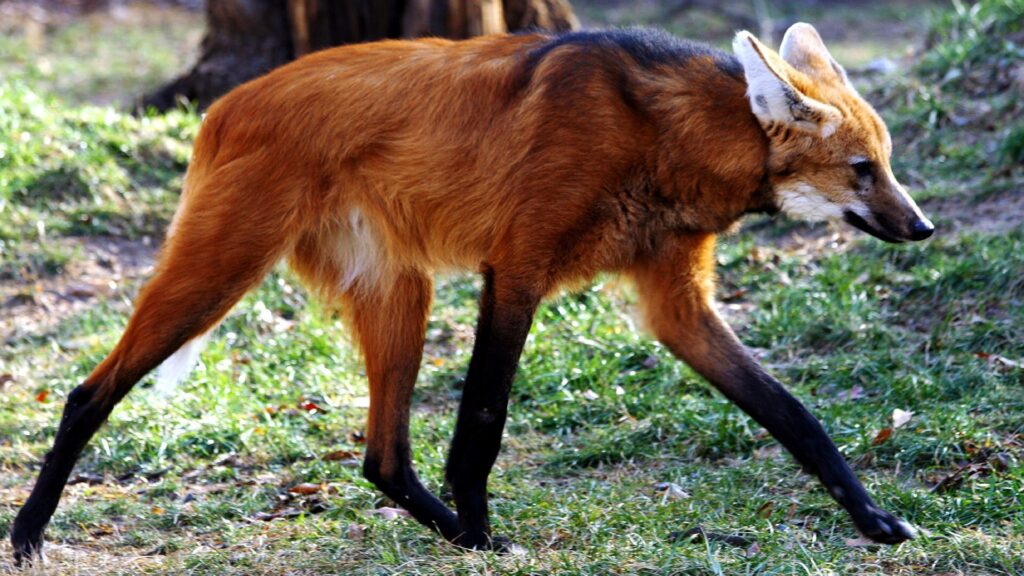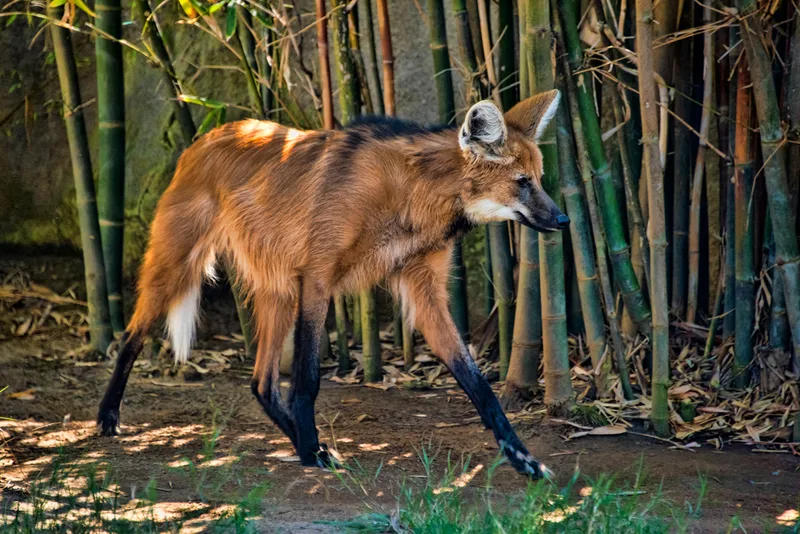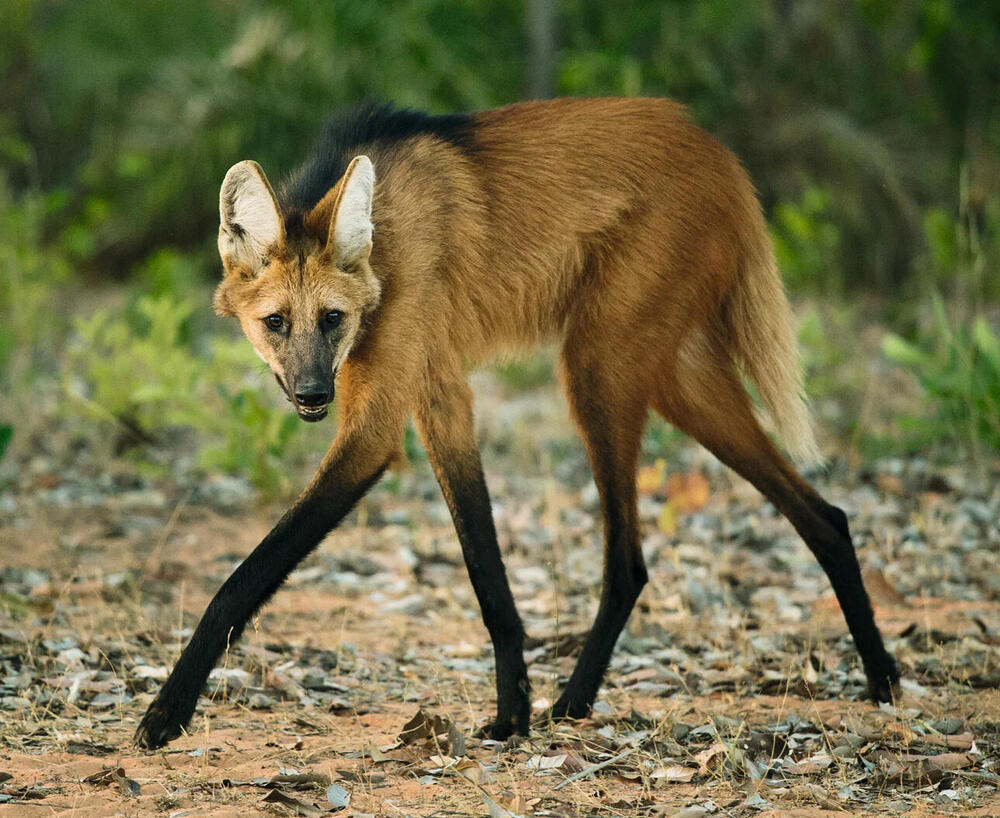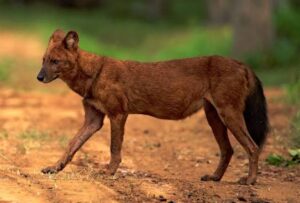Maned Wolf (Chrysocyon brachyurus) – The Fox on Stilts
Introduction
The maned wolf is one of the most enigmatic and visually striking canids in the world. Often described as a “fox on stilts,” this species is actually neither a fox nor a wolf. Native to South America, it belongs to its own unique genus, Chrysocyon, which translates to “golden dog.” With its towering legs, reddish-orange fur, and solitary behavior, the maned wolf is a fascinating creature that plays a vital role in the ecosystems it inhabits.
Physical Characteristics
Standing around 75 to 90 cm (2.5 to 3 feet) tall at the shoulder and weighing between 20–26 kg (44–57 pounds), the maned wolf is the largest canid in South America. Its most notable features include:
- Extremely long legs, which evolved to help it see above the tall grasses of the savanna.
- A reddish coat contrasted with black legs, a black mane, and a white-tipped tail.
- A large, fox-like head with erect ears and a slim, graceful body.
The “mane” running down the back of its neck can be raised to make it appear larger when threatened. This is both a defensive adaptation and a method of communication with other maned wolves.

Habitat and Range
The maned wolf primarily inhabits the Cerrado, a vast tropical savanna ecoregion in central Brazil. However, its range extends into parts of Argentina, Paraguay, Bolivia, and Peru. It prefers open grasslands, scrub forests, and marshes, areas that provide cover and a variety of food sources.
Historically, the maned wolf also lived in parts of Uruguay, but it is now likely extinct there due to habitat loss and human encroachment.
Behavior and Lifestyle
Maned wolves are solitary and elusive, active mostly at dawn and dusk—a behavior known as crepuscular activity. While they may form monogamous pairs, they typically do not live or hunt together. Each individual maintains a large territory ranging from 25 to 115 square kilometers, which they patrol and mark with strong-smelling urine.
They are generally non-aggressive toward other canids and avoid confrontation. Encounters between maned wolves are rare, but when they do occur, they rely on body posturing, raised manes, and vocalizations rather than direct conflict.

Communication
The maned wolf communicates through:
- Scent-marking: Their urine has a strong, musky odor, often compared to cannabis. This is used to mark territory and indicate reproductive status.
- Vocalizations: The most distinctive sound is a deep, single-syllable “roar-bark,” which can be heard over long distances. Unlike wolves, they do not howl.
These communication methods are essential for maintaining their solitary lifestyle and avoiding unnecessary conflict with neighboring wolves.

Diet and Feeding Habits
Despite their appearance, maned wolves are omnivores. Their diet is extremely varied and consists of about 50% plant matter and 50% animal matter.
Common foods include:
- Fruits (especially the wolf apple, a tomato-like fruit endemic to the Cerrado)
- Tubers and roots
- Small mammals (rabbits, rodents)
- Birds and their eggs
- Reptiles, insects, and amphibians
The wolf apple is especially important, as it not only provides a vital food source but also aids in digestive health and may help combat parasites. Maned wolves are also important seed dispersers, particularly for the plants they consume, playing a crucial ecological role.

Reproduction and Lifespan
The maned wolf has a very short breeding season. Females come into heat only once a year, typically between April and June. After a gestation period of 60 to 65 days, the female gives birth to 2 to 6 black-furred pups. These pups will:
- Open their eyes within the first two weeks
- Be weaned by 3–4 months
- Reach sexual maturity around 1 year old
Parental care includes feeding the pups regurgitated food. In captivity, males have been observed helping raise the pups, and it’s believed this might also happen in the wild.
Maned wolves can live up to 12–15 years in captivity, though their lifespan in the wild is often shorter due to disease, road mortality, and habitat threats.
Conservation Status
The maned wolf is currently classified as Near Threatened on the IUCN Red List. Their population is declining due to a combination of factors:
- Habitat loss: Agricultural expansion, especially soy farming and cattle grazing, is fragmenting the Cerrado and destroying maned wolf habitats.
- Road mortality: As roads cut through their range, vehicle collisions have become a major cause of death.
- Human conflict: In some areas, maned wolves are mistakenly blamed for killing livestock and are persecuted.
- Disease: Domestic dogs can transmit fatal diseases such as rabies, distemper, and parvovirus. Parasites like the giant kidney worm also pose a threat.
Despite being legally protected in most countries within their range, enforcement is often weak. Conservation programs focus on habitat preservation, education, and captive breeding to ensure the species’ survival.
Fascinating Ecological Role
The maned wolf is not just a charismatic species; it is also a keystone species in its ecosystem. Its role in seed dispersal—especially of the wolf apple—helps maintain plant diversity and ecosystem stability. Interestingly, maned wolf feces, filled with seeds, are often collected by leafcutter ants, who unintentionally assist in the germination of those seeds by discarding them near their fungus gardens.
Such interspecies interactions underline the wolf’s importance beyond its individual survival—its presence signals a healthy, functioning savanna ecosystem.
Conclusion
The maned wolf is a true icon of South America’s grasslands—mysterious, solitary, and vital to its environment. With its fox-like appearance, towering limbs, unique vocalizations, and surprising diet, this animal offers a rich narrative for science communicators and wildlife enthusiasts alike.
But as the pressures of agriculture, urbanization, and disease close in, the fate of this captivating creature hangs in the balance. Understanding and sharing its story is one of the best ways to promote its conservation and ensure future generations will still have a chance to glimpse this “fox on stilts” wandering through the tall grasses of the wild.




